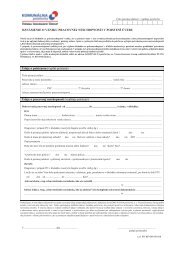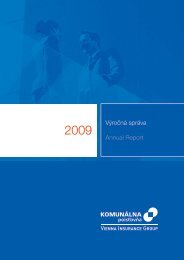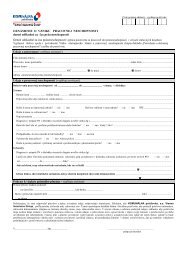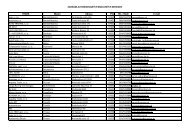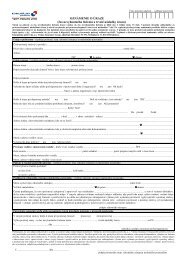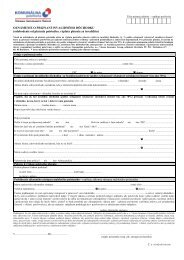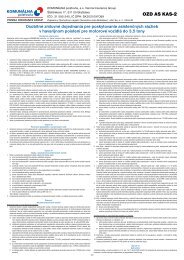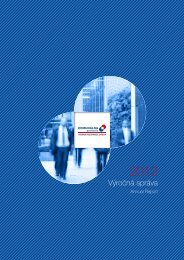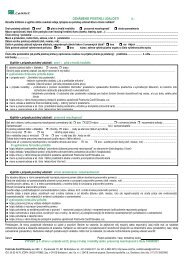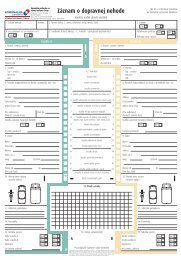kontinuita - Komunálna Poisťovňa
kontinuita - Komunálna Poisťovňa
kontinuita - Komunálna Poisťovňa
You also want an ePaper? Increase the reach of your titles
YUMPU automatically turns print PDFs into web optimized ePapers that Google loves.
NOTES TO<br />
THE FINANCIAL<br />
STATEMENTS<br />
(ii) Estimates of future cash inflows from insurance<br />
premiums received<br />
Uncertainty in the estimation of future insurance benefits<br />
and premium confirmations from long-term insurance<br />
contracts arises from the unpredictability of<br />
long-term changes in overall levels of mortality and<br />
the variability in policyholder behaviour.<br />
The Company uses various mortality tables for different<br />
types of insurance (death, mixed insurance or pension<br />
insurance). The Company uses the statistics in<br />
respect to voluntary policy cancellations to find out the<br />
deviation of the actual experience with policy cancellations<br />
compared to assumptions. Statistical methods<br />
are used to estimate the appropriate lapse ratio. For<br />
insurance policies with the guaranteed annuity payment<br />
option, the level of insurance risk also depends<br />
on the number of policyholders who will exercise the<br />
annuity benefit option. The lower the current market<br />
interest rates compared to implicit interest rates guaranteed<br />
in annuity benefits, the more probable it is that<br />
policyholders will exercise their option to have annuity<br />
payments. The continuing prolongation of life, reflected<br />
in current annuity rates, increases the probability that<br />
the insurance risk for the Company will be higher, as<br />
the policyholders will prefer annuity payments. For the<br />
time being, the Company does not have enough historical<br />
data used as a basis for estimating the number<br />
of policyholders who will exercise the annuity payment<br />
option.<br />
4.2 Financial risk<br />
As a result of its activities, the Company is exposed to<br />
financial risk through its financial assets, financial liabilities,<br />
liabilities from insurance, and assets and liabilities<br />
from reinsurance. In particular, the key<br />
financial risk is the risk that the proceeds from the<br />
Company’s financial assets will not suffice to fund its<br />
liabilities arising from insurance and investment contracts.<br />
The most important financial risk components<br />
are market, credit, interest, and liquidity risks. The<br />
most important market risk components are currency,<br />
fair value, and price risks.<br />
In general, the risk management program focuses on<br />
the unpredictability of situations on the financial markets<br />
and seeks to minimize any potential adverse effects<br />
on the Company’s financial position.<br />
4.2.1 Liquidity risk<br />
The basic principle for managing assets and liabilities<br />
is to invest into securities the nature of which corresponds<br />
to the nature of insurance contracts they relate<br />
to.<br />
In life insurance, the Company matches cash flows<br />
from financial assets and insurance contracts in each<br />
year so that every year, the present value of cash inflows<br />
from financial assets is at least as high as the<br />
present value of future liabilities arising from these insurance<br />
contracts. The Company’s management evaluates<br />
the cash flow coverage on a monthly basis and<br />
makes decisions about the allocation of assets with respect<br />
to their matching with liabilities. The Company<br />
also makes sure that the income generated from such<br />
financial assets always exceeds the interest rate guaranteed<br />
in life insurance contracts.<br />
The Company faces the risk of daily requirements for<br />
available cash mainly due to its insurance activities<br />
(claim settlement). Liquidity risk is the risk that cash<br />
will not be available at an adequate cost to cover insurance<br />
liabilities when they become due. The Company<br />
has set limits to maintain a sufficient amount of<br />
available funds to settle all liabilities due.<br />
KONTINUITA ANNUAL REPORT 127



